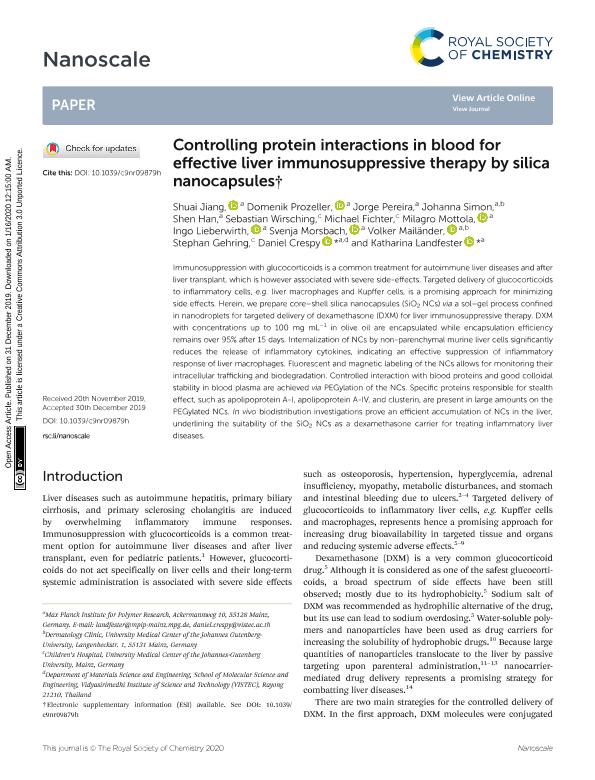Mostrar el registro sencillo del ítem
dc.contributor.author
Jiang, Shuai
dc.contributor.author
Prozeller, Domenik
dc.contributor.author
Pereira, Jorge
dc.contributor.author
Simon, Johanna
dc.contributor.author
Han, Shen
dc.contributor.author
Wirsching, Sebastian
dc.contributor.author
Fichter, Michael
dc.contributor.author
Mottola, Milagro

dc.contributor.author
Lieberwirth, Ingo
dc.contributor.author
Morsbach, Svenja
dc.contributor.author
Mailänder, Volker
dc.contributor.author
Gehring, Stephan
dc.contributor.author
Crespy, Daniel
dc.contributor.author
Landfester, Katharina
dc.date.available
2020-08-19T12:35:23Z
dc.date.issued
2020-01
dc.identifier.citation
Jiang, Shuai; Prozeller, Domenik; Pereira, Jorge; Simon, Johanna; Han, Shen; et al.; Controlling protein interactions in blood for effective liver immunosuppressive therapy by silica nanocapsules; Royal Society of Chemistry; Nanoscale; 12; 4; 1-2020; 2626-2637
dc.identifier.issn
2040-3364
dc.identifier.uri
http://hdl.handle.net/11336/111896
dc.description.abstract
Immunosuppression with glucocorticoids is a common treatment for autoimmune liver diseases and after liver transplant, which is however associated with severe side-effects. Targeted delivery of glucocorticoids to inflammatory cells, e.g. liver macrophages and Kupffer cells, is a promising approach for minimizing side effects. Herein, we prepare core–shell silica nanocapsules (SiO2 NCs) via a sol–gel process confined in nanodroplets for targeted delivery of dexamethasone (DXM) for liver immunosuppressive therapy. DXM with concentrations up to 100 mg mL−1 in olive oil are encapsulated while encapsulation efficiency remains over 95% after 15 days. Internalization of NCs by non-parenchymal murine liver cells significantly reduces the release of inflammatory cytokines, indicating an effective suppression of inflammatory response of liver macrophages. Fluorescent and magnetic labeling of the NCs allows for monitoring their intracellular trafficking and biodegradation. Controlled interaction with blood proteins and good colloidal stability in blood plasma are achieved via PEGylation of the NCs. Specific proteins responsible for stealth effect, such as apolipoprotein A-I, apolipoprotein A-IV, and clusterin, are present in large amounts on the PEGylated NCs. In vivo biodistribution investigations prove an efficient accumulation of NCs in the liver, underlining the suitability of the SiO2 NCs as a dexamethasone carrier for treating inflammatory liver diseases.
dc.format
application/pdf
dc.language.iso
eng
dc.publisher
Royal Society of Chemistry

dc.rights
info:eu-repo/semantics/openAccess
dc.rights.uri
https://creativecommons.org/licenses/by/2.5/ar/
dc.subject
SILICA NANOCAPSULES
dc.subject
PROTEIN INTERACTIONS
dc.subject
DEXAMETHASONE
dc.subject
IMMUNOSUPPRESSIVE THERAPY
dc.subject.classification
Química Coloidal

dc.subject.classification
Ciencias Químicas

dc.subject.classification
CIENCIAS NATURALES Y EXACTAS

dc.title
Controlling protein interactions in blood for effective liver immunosuppressive therapy by silica nanocapsules
dc.type
info:eu-repo/semantics/article
dc.type
info:ar-repo/semantics/artículo
dc.type
info:eu-repo/semantics/publishedVersion
dc.date.updated
2020-05-07T14:23:32Z
dc.identifier.eissn
2040-3372
dc.journal.volume
12
dc.journal.number
4
dc.journal.pagination
2626-2637
dc.journal.pais
Reino Unido

dc.description.fil
Fil: Jiang, Shuai. Max-Planck-Institut für Polymerforschung; Alemania
dc.description.fil
Fil: Prozeller, Domenik. Max-Planck-Institut für Polymerforschung; Alemania
dc.description.fil
Fil: Pereira, Jorge. Max-Planck-Institut für Polymerforschung; Alemania
dc.description.fil
Fil: Simon, Johanna. Max-Planck-Institut für Polymerforschung; Alemania. Johannes Gutenberg Universitat Mainz; Alemania
dc.description.fil
Fil: Han, Shen. Max-Planck-Institut für Polymerforschung; Alemania
dc.description.fil
Fil: Wirsching, Sebastian. Johannes Gutenberg Universitat Mainz; Alemania
dc.description.fil
Fil: Fichter, Michael. Johannes Gutenberg Universitat Mainz; Alemania
dc.description.fil
Fil: Mottola, Milagro. Consejo Nacional de Investigaciones Científicas y Técnicas. Centro Científico Tecnológico Conicet - Córdoba. Instituto de Investigaciones Biológicas y Tecnológicas. Universidad Nacional de Córdoba. Facultad de Ciencias Exactas, Físicas y Naturales. Instituto de Investigaciones Biológicas y Tecnológicas; Argentina. Max-Planck-Institut für Polymerforschung; Alemania
dc.description.fil
Fil: Lieberwirth, Ingo. Max-Planck-Institut für Polymerforschung; Alemania
dc.description.fil
Fil: Morsbach, Svenja. Max-Planck-Institut für Polymerforschung; Alemania
dc.description.fil
Fil: Mailänder, Volker. Max-Planck-Institut für Polymerforschung; Alemania. Johannes Gutenberg Universitat Mainz; Alemania
dc.description.fil
Fil: Gehring, Stephan. Johannes Gutenberg Universitat Mainz; Alemania
dc.description.fil
Fil: Crespy, Daniel. Max-Planck-Institut für Polymerforschung; Alemania. Vidyasirimedhi Institute of Science and Technology; Tailandia
dc.description.fil
Fil: Landfester, Katharina. Max-Planck-Institut für Polymerforschung; Alemania
dc.journal.title
Nanoscale
dc.relation.alternativeid
info:eu-repo/semantics/altIdentifier/url/https://pubs.rsc.org/en/content/articlelanding/2020/NR/C9NR09879H
dc.relation.alternativeid
info:eu-repo/semantics/altIdentifier/doi/http://dx.doi.org/10.1039/c9nr09879h
Archivos asociados
